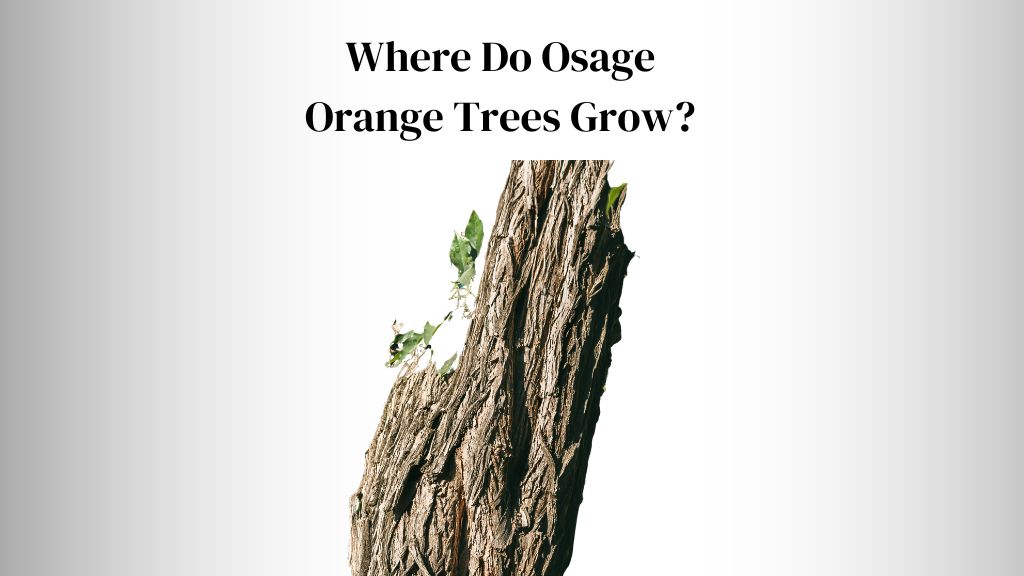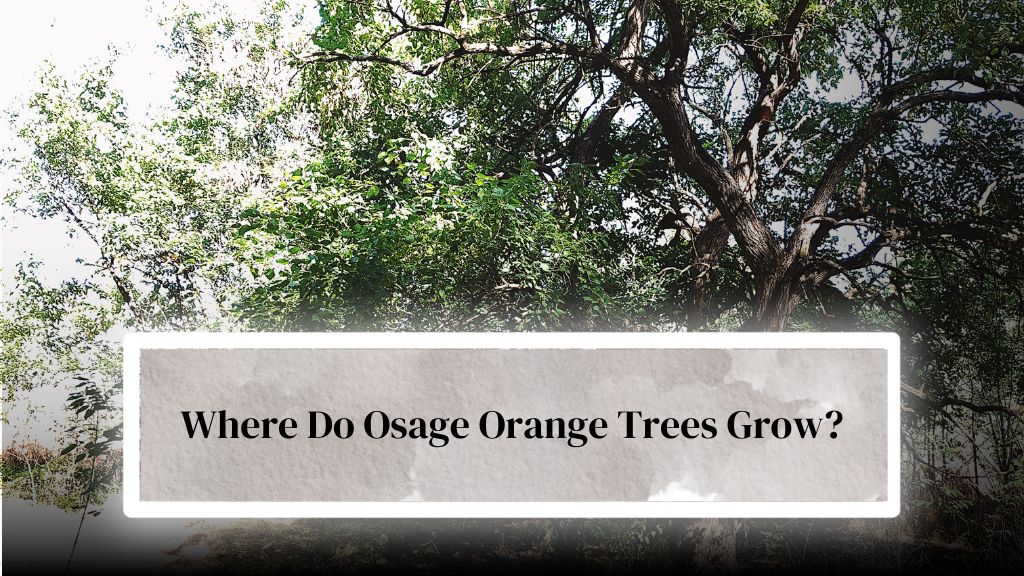
If you want to know where do osage orange trees grow, you are in the right article. Here, we’ll not only be going to cover the native range as well as areas where these trees are mostly found but also tell you what role they play in their ecosystem & biodiversity.
We will also look at the cultural & ecological significance of history as a keystone species. But before all of these, let’s take a quick look at where Osage Orange trees grow & their environmental impact.
Where Do Osage Orange Trees Grow

In general, Osage Orange trees (Maclura pomifera) are native to the central United States, particularly Texas, Oklahoma, Arkansas, & Missouri. However, this specimen can be found in other parts of the country, especially near prairies, riverbanks, and woodlands.
Worldwide, the Osage Orange tree is commonly used as an ornamental tree, in fence rows & along roadsides. Since this plant can thrive in All types of soil, they’re often found near savannas.
According to the United States Department of Agriculture (USDA), Osage Orange trees can grow up to 50 feet tall & have a lifespan of up to 150 years. They are known for their hard, dense wood & thorny branches, and their fruit, which resembles a large, greenish-yellow brain, is often used for decoration.
Plus, If you like bird watching or want to attract pollinators & beneficial insects to your landscape, consider having this specimen in your garden as a border plant or as a Focal Point along with other companion plants.
You should know that Osage Orange trees thrive in areas that experience hot summers & mild winters. You should provide them with full sun exposure & well-draining soil.
In addition, creating a slope can also help you out In preventing waterlogging. Do you know the woods of the Osage Orange tree have been frequently used for making bows and other wooden tools in Asia & Africa? If you want, you can also learn How To Make A Bow From Osage Orange Wood.
Ecological Significance
Osage Orange Trees as a Keystone Species
In their native range, Osage Orange trees are considered a keystone species because they play a very vital role in their ecosystem. They not only provide a good source of food when the foods are scarce during winter or fall but also shelter varieties of wildlife, including deer, rodents, and birds.
Also, this species is known to deter pests & diseases, making it better for their surrounding plants to thrive. Since they also produce fruit that attracts many kinds of insects and pollinators, including butterflies and bees, gardens with lots of fruiting trees also benefit from this specimen.
Also Check: Are Osage Oranges Edible?
Role in the Ecosystem and Biodiversity
As I told you earlier, the Osage Orange tree is a keystone in their Habitat because it plays a vital role in its ecosystem & biodiversity. Not only it provides shelter & food, but it also helps in preventing soil erosion while reducing water runoff.
If you want to improve your garden or landscape soil quality, consider having this species because it increases soil organic matter and nutrient cycling. A study published in the MDPI, trees like the osage orange trees leaves & twigs contain high levels of phosphorus & nitrogen, which is beneficial for soil fertility and its surrounding plants.
Interactions with Other Organisms
You should know that Osage Orange trees have a complex relationship with other organisms in the ecosystem. They are hosts to various insect species, including the Osage Orange aphid and the Osage Orange weevil. However, these insects feed on the leaves & twigs of your tree but do not cause significant damage to the overall health of osage orange trees.
Related article: What Are Osage Oranges Good For?
Cultural Significance
Osage Orange Trees in Native American Culture
You should know that Osage Orange trees have significant cultural significance in Native American cultures. The Osage tribe, native to the central United States, used the wood from these trees for making bows & other tools. Also, they were interested in using the fruit of the osage orange trees for medicinal purposes.
People Also Read: Can You Eat Osage Orange Fruit
Symbolism & Meaning
Interestingly, Osage Orange trees are also symbolic in many cultures. In Chinese culture, these trees are associated with good luck & prosperity. In Western cultures, the tree is associated with strength, longevity, & resilience.
Contemporary Cultural Significance
In contemporary culture, Osage Orange trees have also gained popularity due to their use in landscaping & as a source of sustainable wood. The wood from these trees is highly valued for its durability and resistance to decay. People often use its wood for woodworking and art & craft. If you want to use this wood as well, here’s “Where To Buy Osage Orange Wood“.
Environmental Impact
Benefits of Osage Orange Trees for the Environment
Overall, Osage Orange trees have a positive impact on the environment. They not only help mitigate climate change by absorbing carbon dioxide from the atmosphere but also help to reduce soil erosion & improve water quality. They also attract many wildlife and provide a protective shelter to animals like deer, rodents, squirrels, birds, and more.
Effects on Soil & Water Quality
You should know that the Osage Orange tree comes with deep roots, which help it improve water infiltration and reduce runoff. Overall, having this tree in your yard will improve water quality while reducing the risk of soil erosion.
Many have reported an increase in soil fertility & reduction in the spread of diseases when planted Orange near aquatic plants. If you also have land or landscape with water features or ponds, consider planting this specimen.
In addition, the leaves & twigs of the Osage Orange tree are said to have compounds rich in anti-microbial properties, making it fairly good for deterring pests.
Management & Conservation Strategies
Fortunately, Osage Orange trees are not considered threatened or endangered. However, their decreasing range can be noticed due to changes in land use & the fragmentation of their Habitat.
We need to conserve these trees by maintaining their natural Habitat & protect them from land-use changes like deforestation and urbanization. But before that, let’s look at the challenges & threats.
Challenges and Threats
Even though Osage orange trees are not considered endangered, they still face several threats to their survival. The most significant threats include diseases, pests, & our (humans) activities.
Diseases
One of the most significant threats to the survival of Osage orange trees has been frequently noticed is disease. The most common diseases that can affect your osage orange trees as well are root rot & crown gall.
Root rot is caused by fungi that attack the tree’s root system, while crown gall is caused by bacteria that enter the tree through wounds. You should avoid over-watering your tree or keeping them flooded, which may lead to root rot.
Pest
Another significant threat to Osage orange trees is pests. Even though this specimen is quite resistant to pests, a few common insects may attack these trees, particularly the Osage orange scale, and the Osage orange webworm.
The scale feeds on your tree’s leaves and twigs, while the webworm attacks the tree’s fruit. Therefore, you should always consider providing nitrogen-rich fertilizer to your Osage Orange tree and practice proper pest control.
To prevent all these problems, consider reading: How to Grow Osage Orange Trees
Human Activities & Land Use Changes
Last, the most prominent threat to Osage orange trees is said to be human activities & land use changes. We continuously remove osage orange trees from their natural environment to make way for development or agriculture.
As you know, removing these trees can have a very poor impact on the surrounding ecosystem because they serve as a shelter and provide food to wildlife varieties.
Conservation Efforts
Despite the threats facing Osage orange trees, several conservation efforts are underway to protect and preserve these trees.
Current Conservation Strategies
Fortunately, Our government is Continuously establishing a protected area to conserve the Osage Orange trees, which is one of the most effective strategies.
You can find many types of wildlife reserves and straight parks that have these trees protected in their natural Habitat & that the wildlife particularly depends on them.
In Suburban and urban areas, a different conservation strategy needed to be practiced to control the planning population of the Trees. I hope people will soon plant these trees in urban and Suburban areas to provide important Habitat to the surrounding wildlife.
Importance of Conservation Efforts
We must put conservation efforts into Osage orange trees to protect the unique ecological benefits these trees provide.
They are not only an important food source for wildlife and provide important Habitat for a variety of species but also have important cultural & historical significance in many regions of North America.
Despite the challenges facing Osage orange tree conservation, there is always a potential for expansion & growth in the future.
Potential for Expansion & Growth
Do Osage orange trees have the potential to expand their range if people get aware of these trees’ benefits & start growing them as ornamental trees in urban & suburban areas?
As climate change alters the distribution of tree species, these trees may become more common in regions where they were once rare. Since more companies & people are using this tree in AgroForestry & industry, there is a huge chance of a potential increase in the species’ overall population.
If you don’t know what Agroforestry is, let me tell you, it is a land-you system where we combine forestry practices with agriculture to create a sustainable ecosystem.
Conclusion
This article gave you a brief idea of where osage orange trees grow and what conservation strategies we need to make. Since it has the potential to increase its population, you should also consider having one in your garden.
Believe it or not, the woods of an Osage Orange tree are also worth good money. I hope you find this article helpful, and if you do, consider sharing it. Your share will help many people learn about the native region where these trees are more active. See you in the next post. Till then, take care and goodbye.
